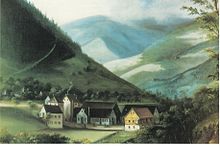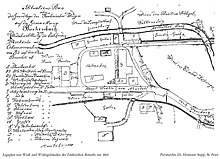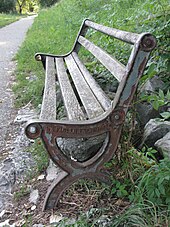Ph. Ant. Lazy
Ph. Ant. Fauler was an ironworks and steel construction company from 1838 to 1919 in Falkensteig and Freiburg im Breisgau .
founding
Philipp Anton Fauler was the tenant of a steel works in Thiergarten . In 1838 he bought the Falkensteig ironworks for his sons Eduard Johann Anton (1819–1882) and Hermann Georg (1821–1882) , which was subsequently named “Ph. Ant. Fauler ”acted. Eduard Fauler lived in Freiburg, where he ran an iron trade and sold the products of the ironworks. From 1859 to 1871 he was also mayor of the city. Hermann initially managed the company in Falkensteig.
![]()
In 1859 the Fauler brothers in Falkensteig also bought the Himmelreich estate, one of the oldest estates in the Dreisamtal. It is mentioned by Zarten as early as 1397 in the Dingrodel, the local constitution.
Falkensteig operation
The original ironworks, which in the past had been called the "Upper Blechschmiede", was located in Falkensteig. It was to the east of the Himmelreich train station, in what is now the “Blechschmiede” residential area. A rolling mill and a large hammer mill with three hammers were operated there. Peat from Hinterzarten and Breitnau and charcoal from charcoal burners from the Black Forest served as fuel . At this operating part included a fresh fire , in the ingots , inter alia, from ferrous Kandern and scrap iron in Luppen were converted, which were forged and processed to bar iron. At the beginning of the 1840s, the rolling mill was taken over by Bernoulli, Rowlandson & Comp. rebuilt and expanded from Immendingen. In addition, a cupola furnace with an iron foundry was built in 1853 .
In 1858, further up in the Höllental, a wire drawing shop was established as the second part of the business , in which pens were also made using water power.
The third facility shown on the site plan was set up in 1860 on Landstrasse opposite the home of Hermann Fauler. It was a small hammer mill in which three hammers were driven by one overshot water wheel and the fan by a second. Axles and plow parts were produced here.
At times the company employed up to 400 workers in this way in the manufacture of rolled, wrought and cast iron.
The early industrial production methods of the Fauler company could not keep pace with the rapid development of the iron industry. In 1872 there were only 41 workers left, producing 300 tons of iron and 150 tons of iron wire. In the same year, the rolling mill had to be stopped because of the unprofitable production using charcoal. The use of hard coal, which was available to the new competition in the Rhineland at a much lower price, had recently been unable to change this situation. The factory buildings were demolished between 1924 and 1928. But one building has been preserved, the "Haus zum Hammer" on Höllentalstrasse. Wire drawing had to be stopped in the 1890s. A sawmill was built in their place. The iron foundry had already burned down in 1866.
Freiburg plant

However, the iron foundry had already been relocated to Freiburg in 1864/65 so that production could continue without interruption. Both companies together employed 120 people at that time. Hermann Fauler also moved to Freiburg in 1866 in order to manage the expanded business including a mechanical workshop. The facilities in Falkensteig were subsequently managed by an administrator. In 1869 there were 100 workers in Freiburg alone.
The factory was located with the associated water rights on the southern arm of the commercial canal with the address Wilhelmstraße 5. It was conveniently located near the train station built in 1845, namely in the area between Faulerstraße, formerly Grünstraße, and which is now named after Eduard Fauler the “old foundry” path . The area in which at that time, in addition to the Fauler company, numerous other businesses were settling, was called “Im Grün”. It was originally part of the open field before the city was fortified. Ph. Ant. Fauler's office was on Kaiserstrasse. In 1881 they were connected to the business premises by the first telephone line in Freiburg.
![]()
The offer consisted of street lamps, spiral staircases, ovens, wheels, plows and household items such as waffle irons or pots, as well as park benches, signposts, liquid manure pumps and water wheels.
In Freiburg you can still find street lights, park benches and numerous portals made of cast iron on the facades of shops, such as Löwenstraße 4, Schusterstraße 25 and 44, Salzstraße 35, Gerberau 6 and 7 or Rathausgasse 24. There are also products in the area of the company, for example in the form of the pillars in the entrance hall of Castle von Ehaben . In 1871 Ph. Ant. Fauler built the cast iron bridge in Staufen .
After the death of the two brothers Hermann and Eduard in 1882, the company was run by Edward's son-in-law, Arthur Pfeilsticker, and Hermann Georg's sons, namely Hermann Eduard and initially Anton (after his departure around 1890: Alfred, author of the notes on the Falkensteig ironworks ). The company now concentrated on steel construction and manufactured bridges and observation towers like
- the Roßkopfturm in Freiburg (1889),
- the observation tower on the Hochblauen above Badenweiler (1895),
- the Tour du Belvédère near Mulhouse in Alsace on the left bank of the Rhine in France (1898),
- the Lembergturm on the highest elevation of the Swabian Alb ("Fauler from Freiburg / Breisgau carried out the work with 12 men in 1899 in a construction period of only 3 months").
The frequent representation in the Freiburg region that these structures were constructed by "the engineer Philipp Anton Fauler" is incorrect. The manufacturer of all structures was the "Ph. Ant. Fauler Company", especially since Philipp Anton Fauler himself had died in 1850.
After Arthur Pfeilsticker died in 1911, Ph. Ant. Fauler was directed by his son Johannes. But this could only handle the settlement. In 1913 the iron foundry went to the Raimann company in St. Georgen . When the First World War broke out, the rest of the operations had to be severely restricted, after which it was liquidated in both Falkensteig and Freiburg.
Individual evidence
- ^ A b c Walter Fauler: History of the lazy families . Bad Krozingen 1994, p. 118
- ↑ a b Ursula Huggle, Ulrike Rödling: Our home in Buchenbach: From parish to parish . ISBN 978-3-922675-63-1 , pages 308-311
- ↑ a b c Alfred Fauler: Notes on the Falkensteig ironworks , typewriter manuscript, 4 (unpaginated) pages, 1936, Freiburg city archive, B1 manuscripts 291
- ↑ a b Johann Baptist Trenkle: History of the Black Forest Industry from its earliest times to our days , 1874, at footnote 197 online
- ↑ Willi A. Boelcke: The Freiburgers were inventive , Schau-Ins-Land 1991, p. 162 online
- ↑ Iso Himmelsbach: Bach tee. Self-published 2005, p. 118.
- ↑ Himmelsbach, p. 140
- ↑ Sample book Ph. Ant. Fauler from 1878 lot-tissimo.com
- ↑ Bertold Zisterer: Lembergturm in new splendor in: Blätter des Schwäbischen Albverein , 1999
- ↑ Alfred Fauler does not give the first name of this son. However, since the other son Joseph was a doctor, it can only have been John.





